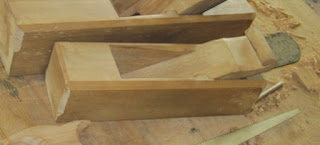Japan was probably my most intense experience. I've traveled internationally before, but never to Asia. In Europe, it seemed like I could get a feel for parts of the different languages I heard, most share certain words or wood roots, but the Japanese language seemed like white noise to my ears, and when you get off an eleven hour flight, it's mid-night at Narita Airport and you're alone, you realize pretty quickly that you aren't in Iowa anymore . . .
Luckily all I had to do was take a shuttle bus to my hotel and English is the international language of tourism, so my first few hours in Japan weren't so daunting. The whole trip had been arranged by one of my uncles who spent a lot of time in Japan on business. His contacts there had helped arrange the trip and even gave me a ride up to Yoshihara's shop.
 |
| Left to right: Yoshihara-san, me, Yazu (Yoshihara's apprentice) |
While Yoshihara worked, I documented the process. Yazu, Yoshihara's current apprentice squatted near the forge watching Yoshihara work and I sat next to him. My western legs weren't conditioned to squat for a long time so my hosts provided me with a chair which sat maybe eight inches off the ground. It wasn't too comfortable either, so I would alternate between squatting and sitting, all the while taking furious notes and pictures.
Prior to this I had spent the summer working with my friend trying to figure out the process. We read the few books available in English (the most complete of which was written by Yoshihara's brother) and watching youtube videos. We put an anvil on the floor and stacked firebrick in an old Champion 400 forge to emulate a Japanese style forge. I cut apart a few old drive shafts and my friend made handles so we could have some Japanese pattern sledge hammers. We billeted and welded all of the high-carbon scrap that I had been accumulating as we attempted to figure out the process. I had almost everyone in the shop swinging a hammer -interns, volunteers, employees, everyone was into the project. The finished billets were worked into paring chisels which I will probably post about later.
Squatting next to Yoshihara's forge, watching the real deal was amazing. Much of our hard work was vindicated. Things we had figured out and even some things we had guessed at were confirmed. But there was so much more too, and I remember thinking that I should have spent some time conditioning my writing hand in preparation for this trip -I couldn't take notes fast enough!
More to come in Part 2




















